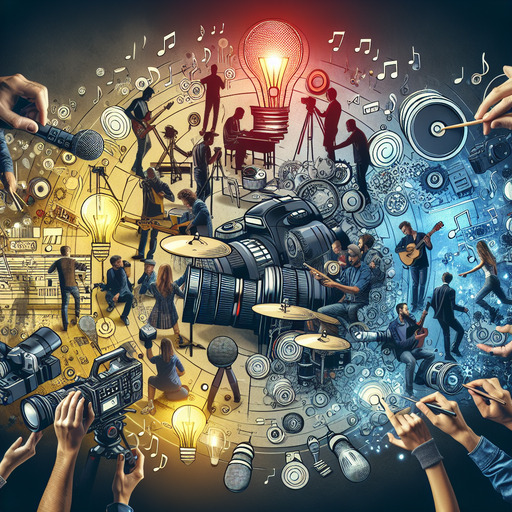
-
Table of Contents
Elevate your music video production with top-tier cameras, mics, and more! Discover the best gear now at Danny Avila’s site. Explore Now!
Introduction
Music video production is a dynamic and multifaceted field that requires a blend of creativity and technical expertise. Central to this process is the gear used to capture and enhance the visual and auditory experience. Cameras are the cornerstone of music video production, with options ranging from high-end cinema cameras to more accessible DSLR and mirrorless models, each offering unique features like 4K resolution, high frame rates, and various lens compatibility. Microphones play a crucial role in capturing high-quality audio, with choices including shotgun mics, lavalier mics, and studio condensers, each suited to different recording environments and needs. Additionally, other essential gear such as lighting equipment, stabilizers, and editing software contribute to the overall production quality, ensuring that the final product is polished and professional. Understanding the capabilities and applications of each piece of equipment is vital for any music video producer aiming to create compelling and visually stunning content.
Essential Gear for Music Video Production: Cameras, Mics, and More
When embarking on the journey of music video production, having the right gear is essential to ensure a high-quality final product. The choice of equipment can significantly impact the visual and auditory experience, making it crucial to invest in the right tools. Among the most critical pieces of gear are cameras, microphones, and various other accessories that contribute to the overall production value.
To begin with, cameras are the cornerstone of any music video production. The type of camera you choose can dramatically affect the visual quality of your video. High-definition cameras, such as DSLRs and mirrorless cameras, are popular choices due to their versatility and ability to capture stunning visuals. These cameras offer interchangeable lenses, allowing for a range of creative shots, from wide-angle to close-ups. Additionally, many of these cameras come equipped with advanced features like 4K resolution, slow-motion capabilities, and excellent low-light performance, which are invaluable for creating visually compelling music videos.
Transitioning from cameras, another indispensable piece of equipment is the microphone. While the primary focus of a music video is often the visual component, the audio quality should not be overlooked. High-quality microphones are essential for capturing clear and crisp sound, whether it’s the artist’s vocals or ambient sounds that add depth to the video. Shotgun microphones are particularly useful for their directional capabilities, allowing you to isolate the sound source and minimize background noise. Lavalier microphones, on the other hand, are excellent for capturing dialogue or vocals discreetly, making them a versatile choice for various shooting scenarios.
In addition to cameras and microphones, several other accessories play a pivotal role in music video production. Lighting equipment, for instance, is crucial for setting the mood and enhancing the visual appeal of your video. Softboxes, LED panels, and ring lights are popular choices that provide consistent and adjustable lighting, helping to eliminate harsh shadows and highlight the subject effectively. Moreover, using color gels and diffusers can add creative effects and soften the light, contributing to the overall aesthetic of the video.
Furthermore, stabilization tools such as tripods, gimbals, and sliders are essential for achieving smooth and professional-looking shots. Tripods provide a stable base for static shots, while gimbals and sliders allow for dynamic and fluid camera movements, adding a cinematic quality to your video. These tools are particularly useful for capturing performance scenes, where smooth motion can enhance the viewer’s engagement and immersion.
Another critical aspect of music video production is post-production, where editing software and hardware come into play. High-performance computers with powerful processors and ample RAM are necessary for handling the demands of video editing. Software like Adobe Premiere Pro, Final Cut Pro, and DaVinci Resolve offer a range of features for cutting, color grading, and adding special effects, enabling you to refine your footage and achieve a polished final product.
In conclusion, the right gear is fundamental to the success of any music video production. Cameras, microphones, lighting equipment, stabilization tools, and editing software all contribute to creating a visually and audibly captivating video. By investing in high-quality equipment and understanding how to use it effectively, you can elevate your music video production and deliver a professional and engaging experience for your audience.
Q&A
1. **What are some essential pieces of gear for music video production?**
– **Cameras:** High-quality DSLR or mirrorless cameras like the Canon EOS R5, Sony A7S III, or Blackmagic Pocket Cinema Camera 6K.
– **Microphones:** Shotgun mics like the Rode NTG3, lavalier mics like the Sennheiser EW 112P G4, and studio mics like the Shure SM7B.
– **Lighting:** LED panels like the Aputure 120D, softboxes, and ring lights.
– **Stabilization:** Gimbals like the DJI Ronin-S, tripods, and sliders.
– **Audio Recorders:** Zoom H6 or Tascam DR-40X for high-quality audio capture.
– **Lenses:** Prime lenses like the Canon EF 50mm f/1.8, wide-angle lenses, and telephoto lenses.
– **Editing Software:** Adobe Premiere Pro, Final Cut Pro, or DaVinci Resolve.
– **Accessories:** Memory cards, batteries, external monitors, and lens filters.